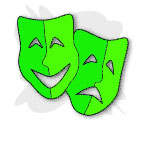

 |
|
||
|
|
A Review
Out Of The Corner and Onto The Dance Floor By R. J. Donovan “Dirty Dancing” is subtitled, “The Classic Story on Stage.” The description is right on the money.
Clearly the crowd on opening night fit that profile to a fault. The houselights dimmed, the heart-pounding music thundered, a silhouette of a dancing couple filled an enormous pink scrim and the crowd erupted into hoots of delight. We were off and running. In keeping with the style of the original film, this is a story with music. There are no book songs to describe situation and push plot, and the main characters never sing. Some of the music is recorded straight out of the summer of ‘63, and the rest is performed live, showcasing the show’s two exceptional vocalists -- Ben Mingay and Aspen Vincent. They play minor characters, but they’re mainly there to sing the songs the crowd longs to hear. (Kudos to the sharp 11 piece orchestra.)
As Baby, Amanda Leigh Cobb (center, above) so resembles Jennifer Grey that you have to look twice. Sweet and innocent, she tags along for a family summer vacation, bored by everything she sees. Until she catches a glimpse of Johnny. As Penny, Johnny’s dance partner, Britta Lazenga (far right, above) is a high-kicking vision. With an incredible form, she dances up a storm. (She comes to the national tour from the Toronto company.)
The stage deck has been built up and out into the house. At its center, the eye-popping set morphs into multiple revolves, spinning, splitting, raising and disappearing with ease. Add to that, massive projections that flood the side walls, and a semicircular LED video wall that whisks us to any number of locations, from the staff cabins at Kellerman’s to the middle of the forest, to the lodge’s sweeping veranda overlooking the lake and even on Johnny’s nighttime car ride beneath a starry sky.
As an example, when all the dancers are center stage at one point, the curved LED screens behind them explode with live camera shots of what’s happening on stage. The effect captures extreme close-ups of the swirling dancers, sometimes blurring and bleeding the images. The effect is its own homage to the opening of the film. Also think back to the point early in the film right after Baby has agreed to fill in for Penny and dance with Johnny at Sheldrake’s resort so the two pros won’t lose their jobs. She’s clumsily trying to learn her steps, and there are several quick edits of her rehearsing, with frustration, as she dances along the footpath and footbridge. The same scene is replicated onstage, almost cut for cut.
And through it all, the hit songs come flying at you, from "Do You Love Me" to "Hungry Eyes," "Hey! Baby!," "Wipeout," and more. The entire evening builds to the final dance sequence. As fans know, by story’s end, Johnny has been fired from Kellerman’s after wrongly being accused of theft. However, he always closes out the summer resort season with his big dance. Despite being canned, he defiantly returns to defend his place, strutting down the Opera House aisle through the orchestra section and leaping onstage. And when he marches over to Dr. Houseman and proclaims, “Nobody puts Baby in a corner,” the crowd cheers like they’re at a Patriot’s game.
In minor differences from the film, the creators have played up the fight for civil rights and tried to add somewhat to the storyline of Baby’s parents. As well, “She’s Like The Wind” (which Patrick Swayze sang as a voiceover in the film), appears here only as an instrumental. The drawbacks are few, but there are a couple. The first act covers about three quarters of the film at a breakneck pace. Which leaves act two far slower in comparison. And the Talent Night scene at Kellerman’s drags -- plus it adds a Pirate Song that serves no purpose but to grind the show to a halt. To close on a few facts and figures: In addition to this national tour (which is reportedly heading to Broadway), there are “Dirty Dancing” productions running in London, Canada, Germany and The Netherlands. The company of 35 goes through 55 songs during 73 scene changes lit by more than 200 moving lights. The character of Baby alone goes through 21 costume changes. Direction is by James Powell, Lighting by Tim Mitchell, Set Design by Stephen Brimson Lewis, Costumes are by Jennifer Irwin, with choreography by Kate Champion. And the deafening cheers are by the throngs of eager film fans heading to The Opera House intent on having the time of their own lives. "Dirty Dancing " is at The Opera House through April 12. For information, call 1-800-982-2787. Production photos: David Scheinmann -- OnStage Boston 02/15/09
|
||||
To
receive an email Update when new pages are posted at OnStage Boston, click
here. |
|||||
©
2002-2004 RJD Associates. All Rights Reserved. No portion of this site may be reprinted or reproduced without prior written permission. |
|||||